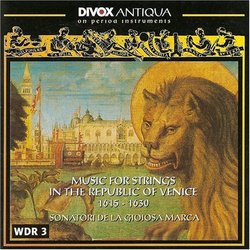| All Artists: Sonatori de la Gioiosa Marca Title: String Music in the Republic of Venice 1615-1630 Members Wishing: 0 Total Copies: 0 Label: Divox Release Date: 7/1/1998 Album Type: Single Genres: Special Interest, Pop, Classical Styles: Vocal Pop, Chamber Music, Historical Periods, Baroque (c.1600-1750) Number of Discs: 1 SwapaCD Credits: 1 UPCs: 723723722126, 7619913797070 |
Search - Sonatori de la Gioiosa Marca :: String Music in the Republic of Venice 1615-1630
 | Sonatori de la Gioiosa Marca String Music in the Republic of Venice 1615-1630 Genres: Special Interest, Pop, Classical
Two dates are delimiting the period from which the pieces on this CD were drawn, and each marks both an end and a beginning: In 1615, Giovanni Gabrieli's Canzoni et Sonate were published posthumously. His music was still b... more » |
Larger Image |
CD Details
Synopsis
Product Description
Two dates are delimiting the period from which the pieces on this CD were drawn, and each marks both an end and a beginning: In 1615, Giovanni Gabrieli's Canzoni et Sonate were published posthumously. His music was still being imitated fifty years later. The year 1630 saw Venice ravished by the plague. Fifty tousand people died, including many singers and musicians working at San Marco, the most important musical institution of Venice. Whereas winds had played a leading role during the Renaissance, now it was the violins which took to the fore and have yet to abandon their position of priority to this day. The violin owed its breakthrough to the fact that it met the needs of the time for a more expressive, individual and variable sound than that afforded by the trombone or cornet. Venice played a major role during this period of upheaval because the town of Brescia also belonged to the Serenissima's sphere of influence. Brescia had been the home of excellent lute builders for generations and many outstanding violinists left Brescia for Venice in order to earn their living there. The recording was done in the mean-tone temperament, that was customary for keyboard instrument at this time. After all, musicians are concerned about discovering the variety of sounds which was equalized in the wake of the developments of the 18th and 19th centuries.

 Track Listings (11) - Disc #1
Track Listings (11) - Disc #1